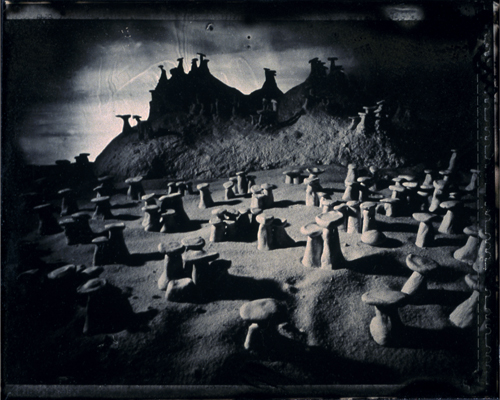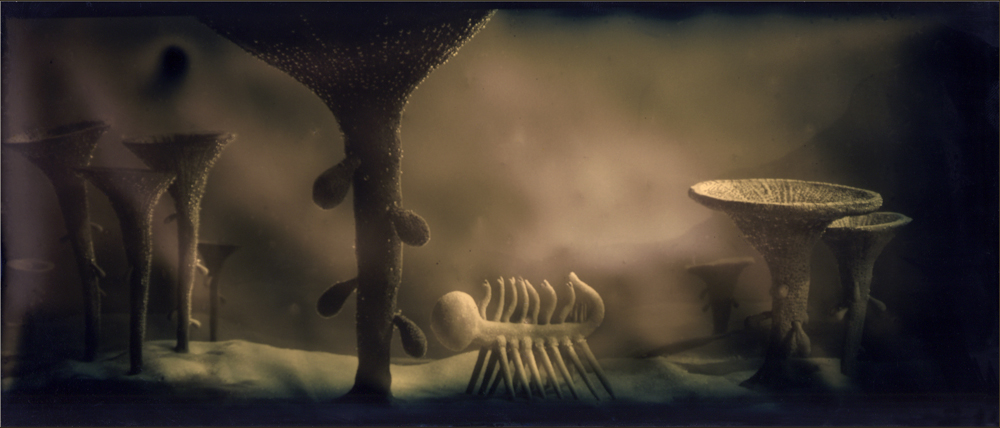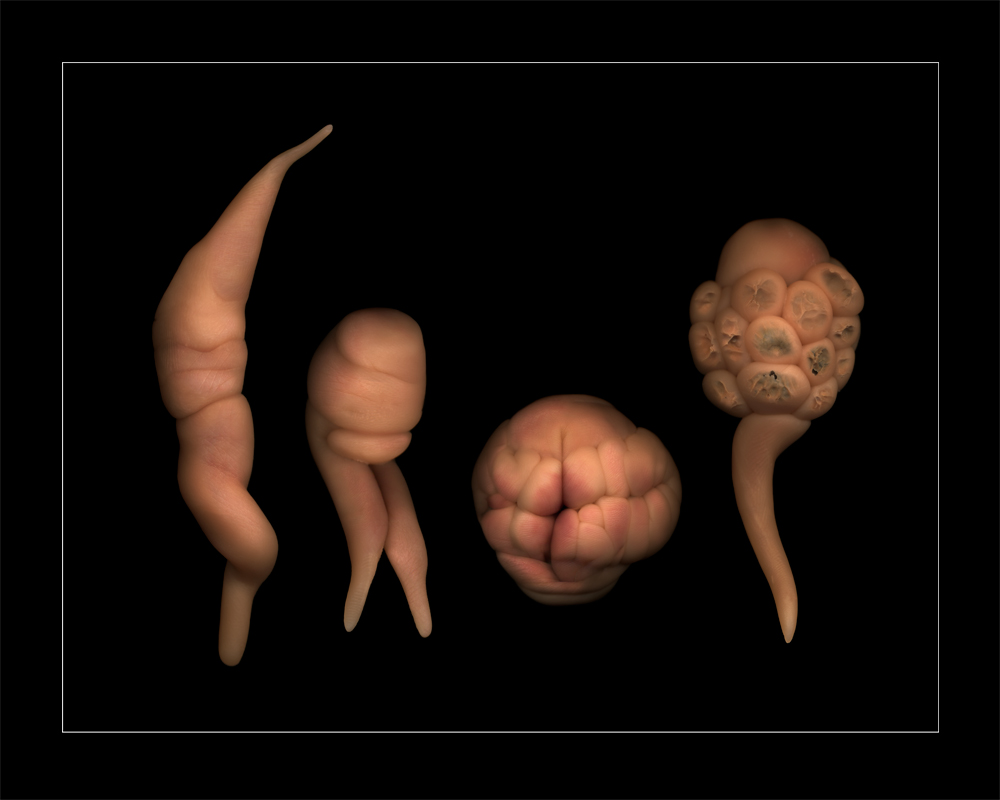Uncharted Territories
 The southwest is a place in the American landscape that is filled with mythic qualities. From the Colorado Plateau to the surrounding terrain there is an inherent surrealness to this topography. Vast and convoluted, the land contains canyons and geological formations that are some of the most spectacular on the planet. Wind, water and particles of sand have sculpted the landscape decorating it with the striations of time. Sand dunes have become petrified and sea creatures are fossilized and embedded in exposed layers of stone. We can touch the shell that belonged to a living entity millions of years ago when the planet was once a vast ocean. Skeletal patterns imprinted in rock emerge like treasures from a lost world. As we explore what remains of the ancient past we are connected to these primitive creatures whose essence has survived through the void of mass extinction. Like time travelers we are witnesses to the planet’s history through these primal sanctuaries preserved by the earth through eons of time.
The southwest is a place in the American landscape that is filled with mythic qualities. From the Colorado Plateau to the surrounding terrain there is an inherent surrealness to this topography. Vast and convoluted, the land contains canyons and geological formations that are some of the most spectacular on the planet. Wind, water and particles of sand have sculpted the landscape decorating it with the striations of time. Sand dunes have become petrified and sea creatures are fossilized and embedded in exposed layers of stone. We can touch the shell that belonged to a living entity millions of years ago when the planet was once a vast ocean. Skeletal patterns imprinted in rock emerge like treasures from a lost world. As we explore what remains of the ancient past we are connected to these primitive creatures whose essence has survived through the void of mass extinction. Like time travelers we are witnesses to the planet’s history through these primal sanctuaries preserved by the earth through eons of time.Uncharted Territories, reinterprets the unique geological formations of the southwestern United States. In my studio I create fictitious environments as room-sized installations. These recreations play upon the mythology of this landscape, bringing ancient creatures and buried treasures back to the Earth’s surface for humanity to explore. When making choices of what to say about the Earth, my passion lies with the forces of creation, and the effects it has had over the immensity of time. Earth’s ancient epochs interest me because they are absent from human recollection and experience. As scientists reconstruct the past they are faced with gaps of missing information, resulting in an interpretation that is based on science and imagination. This lack of evidence is my artistic license to build and photograph a vanished world the way I imagine it to have been.
Technical Information
The landscapes in these photographs are of 3-dimensional sets that range in size from tabletop set-ups to room-sized installations. Using Styrofoam, newspaper, tape and tinfoil I build these forms and then cover them with a sculpting compound. They are then textured and painted and placed in front of a painted sky background. After lighting the landscapes, I photograph them with a 4” x 5” view camera or pinhole camera. The photographs are printed onto black glass that has been coated with silver gelatin emulsion.
Organic Remains of a Former World

“Organic Remains of a Former World”, is a series of photographs depicting ancient marine environments from each of the seven periods in the Paleozoic era. Extinct vertebrates and invertebrates are brought back to life, coexisting in these underwater dioramas. When creating images of these water worlds, I use scientific data to inform my ideas. Illustrations of fossils guide me while building the flora and fauna for each scene.
The idea for this series developed through my ongoing interest in geology and the way landscapes change over time. As a photographer, I think about the abundance of landscape imagery and wonder, what terrain is left to explore? Do any uncharted territories remain?
Technical Information
Using clay, I sculpt all the creatures and rock formations in these underwater landscapes. The sculptures are fired and then submerged in the water of multiple 55-gallon aquariums. I then photograph these tableaux in my studio using controlled lighting and a 4 x 5” view camera. Next, I print the images as contemporary ambrotypes using 9 x 23” black glass that I hand-coat with silver gelatin emulsion. Multiples of each image are made, each being unique due to the inconsistency inherent in hand-coating. The organic nature of this process adds to the rendition of these watery scenes by the serendipitous appearance of bubbles, streaks and obliterated areas of darkness.
New Kingdoms
 The photographs in this series, New Kingdoms, are inspired by current scientific practices that experiment with biological engineering of live tissue. In facilities throughout the world, scientists use stem cells to grow body parts and organs for transplantation onto other living beings. This is done by injecting human or animal stem cells into a mold in the shape of a chosen organ where the cells then multiply and replicate that organ. Another method of creation begins with thin patches of flesh that are stretched across scaffolding; the scaffolding acts as an armature to support the growth and shape of the form. The developed body parts are kept under refrigeration until needed. As of 2009, the pursuit of growing circulatory systems for body parts is underway, expanding the possibilities of organ creation and its disembodied survival.
The photographs in this series, New Kingdoms, are inspired by current scientific practices that experiment with biological engineering of live tissue. In facilities throughout the world, scientists use stem cells to grow body parts and organs for transplantation onto other living beings. This is done by injecting human or animal stem cells into a mold in the shape of a chosen organ where the cells then multiply and replicate that organ. Another method of creation begins with thin patches of flesh that are stretched across scaffolding; the scaffolding acts as an armature to support the growth and shape of the form. The developed body parts are kept under refrigeration until needed. As of 2009, the pursuit of growing circulatory systems for body parts is underway, expanding the possibilities of organ creation and its disembodied survival. The life forms I create are sculptures made from a combination of materials that are synthetic or no longer living. These life-like entities simulate the process of growth, mutation and reproduction that a scientifically produced organism may undergo in a research laboratory. After I create these specimens they are photographed and documented through a classification system categorized according to similarities. As an artist, my entities are created without medical purpose and are benign in their existence. Contrary to my approach, there is the potential to use tissue engineering for unorthodox purposes. Unsettling to think about are the possibilities of autonomy and adaptation of new living systems outside of a clinically controlled environment.
These imaginings have led me to make photographs that depict a world where engineered “individuals” are transplanted into the Earth’s natural landscapes. In these scenarios, human flesh exists in various grotesque amputations that are left to thrive or die as they adapt to an alien world. As these entities populate our planet, the evolution of these new species' will usher the Earth into a new epoch in the history of life.